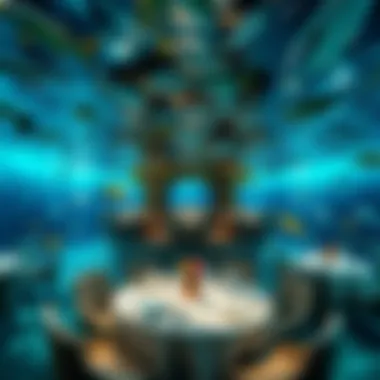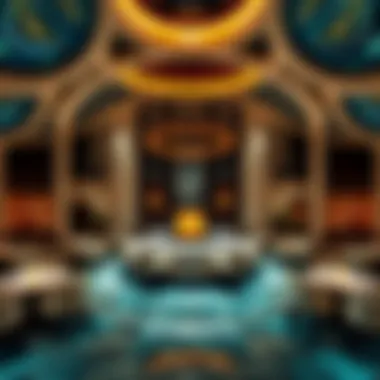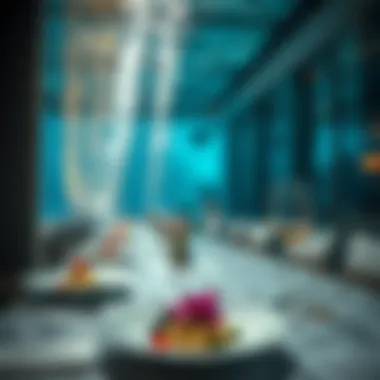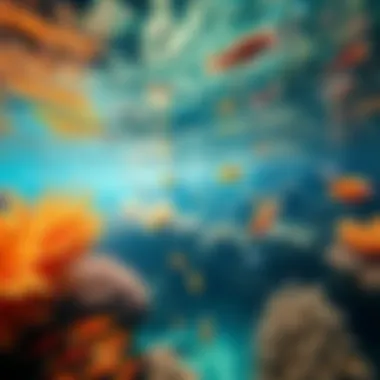Discovering Dubai's Underwater Dining Experience


Intro
Dubai has a flair for the extravagant, and its underwater restaurant is no exception. Nestled beneath the shimmering waves of the Arabian Gulf, this venue doesn't just offer a meal; it crafts an experience that resonates with both locals and tourists alike. This article sets out to uncover the intricacies of this architectural feat, examining its design, culinary offerings, and the broader implications for the hospitality sector in this dynamic city.
As we take a closer look at the restaurant’s innovative concept, its interaction with marine life, and the cutting-edge technologies that underpin its operations, readers will gain insights into how such attractions play a pivotal role in shaping Dubai’s image as a hub for luxury and innovation. Engaging in underwater dining is not just about nourishment but also about how the environment enhances this encounter—ushering us into the realm of culinary art, where gastronomy meets marine wonder.
Additionally, we will touch on the restaurant’s impact on the real estate market, reflecting on current trends and future forecasts. After all, successful ventures in Dubai’s hospitality sector often mirror the urban landscape's evolution, influencing property investments and community development.
Join us as we dive into this marvel that seamlessly blends architecture with culinary excellence, and explore its significance within the thriving tourism industry.
Prolusion to Underwater Dining in Dubai
The concept of underwater dining is one that has intrigued the culinary world for decades. In many ways, it stands at the intersection of gastronomy and the unparalleled beauty of marine life. Dubai is no stranger to bold ideas and innovations, making it a prime location for this unique dining experience. The underwater restaurant not only offers a meal; it provides an adventure, creating an immersive environment where guests dine while surrounded by the splendor of the sea.
The Concept of Underwater Restaurants
Underwater restaurants take the ordinary act of eating and transform it into an extraordinary journey through a captivating aquatic world. Imagine enjoying gourmet dishes while schools of colorful fish glide past, or watching a diver at work through a panoramic window. This concept transcends mere sustenance; it aims to create a multisensory experience that engages not just the palate but the eyes and senses as well.
Consider the design—geometric enclaves built from strong, clear materials that withstand water pressure, seamlessly merging technology with architecture. Every meal becomes a theatrical affair, where the ambiance shifts in real-time as marine life exudes its natural beauty just beyond the glass.
This type of dining often attracts adventurous foodies and nature enthusiasts alike, presenting a once-in-a-lifetime experience that adds layers to a standard dinner. The atmosphere is rich with the sound of water gently flowing, coupled with the sight of vibrant aquatic life, urging a moment of reflection and awe.
Dubai's Unique Position in Dining Innovation
Dubai, known for its extravagant lifestyle and architectural wonders, has carved out a niche in the realm of avant-garde dining. It's a city that embraces the outlandish and celebrates creativity. Underwater dining is a fitting addition to its eclectic culinary scene.
The Emirate's investors and developers are keen to capitalize on such unique ventures, understanding that they not only lure in tourists but also elevate the city’s status as a global hub for innovative dining experiences. Restaurants like the underwater establishment draw not just the casual diner but attract business partners, investors, and real estate agents eager to be part of a groundbreaking project.
Inside Dubai's underwater restaurant, guests are enveloped by the thrill of the experience. They are usually treated to expertly curated menus that reflect both local and international flavors, emphasizing fresh, sustainable ingredients. This commitment to quality pairs perfectly with the restaurant's ambiance and unique setting. Essentially, Dubai's underwater dining stands as a testament to its ongoing push toward culinary excellence, showcasing how far the city is willing to go to redefine dining pleasure.
This intersection of design, ecology, and luxurious dining speaks volumes to those invested in the future of hospitality in the region. With the rise of underwater restaurants, the doors open wider for future endeavors that combine eating, environment, and entertainment, paving the way for a remarkable evolution in the dining landscape.
Design and Architecture of Underwater Restaurants
The design and architecture of underwater restaurants play a pivotal role in capturing the unique experience they offer. It's not just about providing a meal; it's about crafting an atmosphere that merges the beauty of marine life with innovative dining. These establishments must carefully balance artistic vision and practical requirements, creating spaces that are visually captivating while ensuring the safety and comfort of guests. As we delve deeper into this topic, we will explore various dimensions that shape these exquisite underwater dining spots.
Structural Considerations
When constructing an underwater restaurant, structural integrity is paramount. The pressures exerted by water at depth create challenges that architects and engineers must navigate. Utilizing robust materials that manage both buoyancy and pressure is crucial. Reinforced glass, for instance, is commonly employed due to its ability to withstand immense water pressure while providing breathtaking views of the aquatic surroundings.
Moreover, the layout must consider factors like accessibility and evacuation routes. A well-thought-out design allows not only for a seamless dining experience but also ensures the safety of patrons and staff in case of an emergency. Incorporating technology, such as advanced monitoring systems, further enhances the safety measures in place.
Aesthetic Choices and Themes
Aesthetics in underwater dining are what set these locations apart from traditional restaurants. Here, the environment becomes a canvas for creativity. Designers often draw inspiration from the ocean itself, employing colors and materials that blend harmoniously with marine life. Soft blues and greens may dominate the color scheme, creating a calming ambiance reminiscent of the sea.


Themes can vary widely—from sleek, modern designs to those evoking the enchanting allure of coral reefs. The interpretation of these themes shapes the overall guest experience and plays a vital role in marketing the establishment. For instance, a restaurant designed to mimic a sunken ship creates a unique narrative, engaging diners' imaginations as they feast on gourmet dishes.
Sustainability in Design
Sustainability should be at the forefront of any architectural endeavor, especially in environments as delicate as underwater ecosystems. Designing such restaurants responsibly involves choosing eco-friendly materials and energy-efficient technologies. Many establishments are now leaning towards using renewable resources such as solar panels and wind energy to power their operations.
Additionally, integrating features that promote marine life—like habitats created to support fish populations—can contribute positively to surrounding ecosystems. Utilizing filtration systems that clean seawater not only aids in providing quality for the establishment’s operations but also ensures minimal disruption to marine environments.
"Designing underwater restaurants is about harmonizing human enjoyment with nature's beauty, ensuring both thrive without harm."
Culinary Experiences Under the Sea
The culinary experiences offered in Dubai's underwater restaurant are not just about food; they embody a fusion of artistry and innovation, engaging the senses in a way that transcends traditional dining. With the mesmerizing backdrop of marine life swimming gracefully outside panoramic glass walls, the diner is lulled into an ambiance that stimulates taste and sight alike. When patrons descend into this aquatic enclave, they find themselves enveloped in an environment that invites exploration, all while indulging in meticulously crafted culinary delights.
Menu Development and Culinary Artistry
The development of a menu in such a unique setting is no small feat. Chefs face a twofold challenge: to create dishes that not only showcase culinary skill but also reflect the surroundings. This is where the artistry begins. Dishes are curated not just based on flavors, but also colors and presentations that draw inspiration from the ocean itself.
The seafood reflects freshness, often sourced directly from local fishermen, ensuring every plate is a celebration of the sea. Ingredients are chosen for their ability to evoke the marine ecosystem—think plates that resemble coral reefs or compositions inspired by waves. Each dish serves as a canvas, compelling diners to appreciate the relationship between the meal and the underwater milieu.
- Signature Dishes: Signature dishes like the spiced sea bass or sea scallops with citrus foam are not merely culinary offerings but tell a story of the diverse flavors present in the local waters.
- Experience Elevation: The artistry doesn’t end with taste; pairing options with marine-themed cocktails adds another layer, enhancing overall experience.
Local Ingredients and Sustainability Practices
Utilizing local ingredients isn’t just a trend; it’s a necessary practice embraced by the underwater restaurant to foster sustainability and support the local community. The use of seasonal and regionally sourced produce helps in reducing carbon footprints often associated with long-distance food transportation.
Fresh fish caught sustainably is prioritized, allowing for a symbiotic relationship between the restaurant and the ocean. In fact, the establishment passionately advocates for sustainable fishing practices, creating partnerships with local fisheries to ensure both quality and environmental responsibility. This commitment to sustainability is communicated to diners, providing them with information on where their food came from.
- Eco-Friendly Practices: Implementing recycling and composting systems within the restaurant showcases a broader dedication toward environmental impact.
- Education: Diners might also engage with sustainability programs, learning about the importance of marine conservation over a fine meal.
Guest Experience and Service Quality
The guest experience at the underwater restaurant is a carefully choreographed dance of service, instilling awe and enjoyment from the moment one steps through the entrance. Professional staff trained in the subtleties of fine dining ensure that every need is anticipated before it is expressed. From the welcome drink to the final dessert, each interaction is marked by attentiveness and a warm touch.
As diners settle into their seats, the spectacular view of marine life can be enjoyed without distractions or interruptions. This careful pacing helps diners connect with their environment, enhancing the experience of savoring each dish. The backdrop of dynamic aquatic movements creates a soothing ambiance, reducing the clamor often associated with commercial dining spaces.
"Dining beneath the waves is more than a meal; it is an experience that stimulates the senses and connects one to the vastness of oceanic beauty."
The Role of Technology in Underwater Dining
Underwater dining is a showcase of elegance, but behind this captivating concept lies a trove of technology that elevates the experience beyond mere aesthetics. The integration of advanced technologies ensures not only the structural integrity of the restaurant but enhances the overall culinary experience while safeguarding both patrons and marine life. The importance of technology in this domain can't be overstated; it is the backbone supporting the restaurant’s unique proposition.
Innovations in Construction Techniques
Building an underwater restaurant brings distinctive challenges, primarily related to pressure, waterproofing, and sustainability. Recent innovations in construction techniques have made ambitious designs feasible. One notable approach is the use of high-strength, tempered glass panels. These panels not only offer breathtaking views of the aquatic environment but also withstand immense pressure from the surrounding water.
Moreover, advancements in construction robotics help streamline the assembly of underwater structures, ensuring precision and safety. Techniques like submersible construction vehicles allow workers to perform underwater installations without significant risk. With the advent of modular building designs, construction projects can reduce waste, minimize installation times, and remain adaptable to various underwater conditions.


Marine Life Integration and Management
The restaurant's ability to blend seamlessly with its aquatic surroundings is a testament to technological innovation in marine life integration. Sensors and monitors play a crucial role in assessing the health of both the coral reefs and resident marine species. These instruments collect data on water temperature, salinity, and oxygen levels, allowing for adjustments to be made promptly to ensure a supportive environment for the marine inhabitants.
Additionally, the restaurant employs aquaponics to cultivate local flora and fauna, directly linking the kitchen’s produce with sustainable practices. This integration not only enriches the culinary offerings but fosters biodiversity, helping to maintain the delicate ecosystem within which the restaurant operates. Managing the interaction between diners and the surrounding wildlife is also key; visual cues and guided experiences promote awareness about underwater ecosystems among guests, enriching their overall experience.
Advanced Safety Procedures
Safety is paramount when operating at such depths, and advanced protocols are in place to ensure the well-being of guests and staff alike. From the onset, the design incorporates robust safety measures, such as multi-layered hull systems that provide emergency barriers against potential leaks. Staff are trained rigorously in emergency protocols, emphasizing quick evacuation procedures, whenever necessary.
Furthermore, technology plays a vital role in real-time monitoring of structural integrity. Automatic alerts signal any changes that could pose risks, allowing for immediate response measures. Emergency oxygen systems and environmental controls further ensure a safe haven should unexpected circumstances arise.
Ultimately, these advanced safety procedures, paired with innovative solutions, create trust and assurance for guests, enabling them to immerse themselves freely in this sublime dining experience without the cloud of anxiety.
In this extraordinary underwater restaurant, technology not only molds the physical structure but also cultivates an atmosphere where human ingenuity harmonizes with the myriad wonders of marine life.
Economic and Community Impact
The impact of Dubai's underwater restaurant extends far beyond the realm of unique dining experiences. It serves as a microcosm of broader economic themes that are prevalent within the tourism and real estate markets, as well as providing insight into community sentiments and cultural reflections. By examining the various dimensions of economic and community effects, one reveals the intertwining nature of hospitality, commerce, and society in Dubai.
Tourism and Economic Benefits
The underwater restaurant has become a significant draw for tourism in Dubai, an already established global tourism hub. Touted for its unique ambiance and stunning views beneath the waves, this dining establishment attracts various visitors, including food enthusiasts, families looking for memorable experiences, and international travelers eager to share their adventures on social media platforms. These tourists help create a ripple effect throughout various sectors. For example:
- Increased foot traffic can boost sales in nearby retail shops and other restaurants.
- Enhancements in related services, such as guided tours and hotel bookings, often correspond with the influx of visitors to specialized attractions.
- The restaurant generates employment opportunities, not just within its staff but also in ancillary services like transportation and hospitality.
All these components contribute to the overall growth of the local economy. As such, investing in the underwater dining sector presents lucrative opportunities not only for restaurateurs but also for the wider community as job creation flourishes.
Influence on Dubai's Real Estate Market
The establishment of an underwater restaurant notably influences Dubai’s real estate market, transforming perceptions and expectations related to luxury developments. Properties located near this architectural gem witness increased demand. Homebuyers and investors often look for properties in proximity to unique attractions, as they represent both lifestyle advantages and investment potential. This phenomenon occurs due to:
- Higher property valuations prompted by the prestige associated with innovative and sought-after amenities.
- Development of lifestyle-oriented neighborhoods focusing on shared experiences, which are integral to attracting higher-value residents.
- Architects and developers are now challenged to incorporate cutting-edge designs that align with the elements of luxury and exclusivity characterized by such attractions.
Ultimately, the intersection of high-end dining with real estate development signifies a shift towards more experiential-driven investments in Dubai's property landscape.
Community Reception and Cultural Reflection
The community’s response to the underwater restaurant has been largely positive, reflecting broader aspirations embraced by Dubai's residents. Locals often view this establishment as a symbol of innovation, artistic expression, and a commitment to distinctive experiences. However, community receptions are nuanced, influenced by several factors:
- Cultural Significance: How the restaurant embraces local culinary traditions alongside its modern twist resonates deeply with the people.
- Environmental Awareness: An increasing focus on sustainability plays into whether the establishment is perceived as a true asset or a potential ecological concern.
- Social Impact: How this venue becomes a focal point for social gatherings, events, and celebrations can significantly strengthen local bonds.
Dubai’s underwater restaurant stands as more than just a place for diners to enjoy their meals; it acts as a forum for cultural exchange, innovation, and economic growth. As the community continues to engage with this pioneering establishment, it will reflect their collective hopes and values, providing a glimpse into Dubai’s evolving identity.
"The future of dining in Dubai is not merely about food, but rather about creating experiences that resonate with the hearts of its people."


In summary, the economic ramifications and community dynamics surrounding Dubai's underwater restaurant serve as key indicators of its broader significance in the region, shaping the narrative of what it means to live and thrive in this vibrant metropolis.
Challenges and Considerations
As we explore the undercurrents of dining innovation, it becomes crucial to address the challenges and considerations that arise in crafting an underwater restaurant experience. The amalgamation of stunning architecture, marine aesthetics, and exquisite culinary offerings can often obscure the shadows lurking beneath the surface.
Environmental Sustainability Issues
Environmental sustainability stands as a key pillar when it comes to underwater dining. In a city like Dubai, where desert landscapes dominate, the introduction of underwater structures raises questions about ecological balance. Aquatic ecosystems are delicate. Thus, it's paramount for restaurateurs to engage in practices that do not harm local marine life.
- Ecosystem Preservation: Constructing an underwater restaurant necessitates thorough environmental impact assessments. The choice of materials, construction methods, and operation protocols all require scrutiny. One must aim for strategies that minimize disturbances to coral reefs and fish habitats.
- Waste Management: Managing waste remains a pressing concern. A robust plan for dealing with food waste and other by-products is essential. Sustainable practices, such as composting organic materials and utilizing biodegradable packaging, should be at the forefront.
- Energy Efficiency: The energy consumption of such a venue can be staggering. It is vital to incorporate energy-efficient systems, like solar-powered lighting and water-saving fixtures, which align with Dubai’s aspirations for sustainable energy use.
By aiding responsible decision-making, these practices not only enhance the restaurant's brand but also resonate with a growing global consciousness about marine conservation.
Maintenance and Operational Hurdles
While the allure of dining beneath the waves captivates, the operational element can ebb and flow with challenges. Maintaining an underwater facility demands meticulous attention to detail and unwavering commitment.
- Structural Integrity: The underwater environment exerts significant pressure on the restaurant's structure. Regular maintenance checks are indispensable to ensure that the integrity of the building remains uncompromised. Cracks and wear can lead to disastrous consequences if not addressed promptly.
- Humidity Control: Managing humidity is another layer of complexity. Water ingress can create a humid environment, leading to mold growth and other issues if not controlled properly. Investing in advanced climate control systems is essential for preserving both the restaurant and its culinary offerings.
- Staff Training: Adequate training for staff on safety protocols and emergency procedures in underwater operations cannot be overstated. Staff must be equipped to handle not only dining service but also safety drills, ensuring that they can act swiftly in case of emergencies.
The journey of establishing an underwater restaurant does not end with its opening. Continuous evaluation and adaptation to these challenges are the tides that will steer it toward a sustainable and successful future.
"Every great rush forward in innovation comes with its share of challenges. It's about riding the waves rather than being overwhelmed by them."
The intricate dance of sustainability and operational management paints a comprehensive picture of what it truly takes to create a remarkable dining experience beneath the waves. This holistic view does not just benefit the venture itself but helps foster a culture of environmental respect and operational excellence, paving the way for future underwater dining experiences.
Looking Ahead: The Future of Dining Underwater
The realm of underwater dining represents not only a culinary adventure but also a significant opportunity for growth and innovation in the hospitality industry. As we peer into the future, it is evident that this niche will continue to evolve, further captivating patrons and investors alike. The focus will shift towards enhancing customer experiences, integrating advanced technology, and addressing sustainability issues while keeping the enchanting allure that attracts guests to these aquatic eateries.
"Underwater dining is like sipping fine wine while diving among coral streets; it’s a taste of adventure and luxury combined."
Emerging Trends in the Underwater Dining Experience
As we look ahead, trends are beginning to blossom in this unique segment of the restaurant industry. One notable trend is the emphasis on immersive experiences. With advancements in augmented reality (AR) and virtual reality (VR), restaurants may soon provide immersive dining journeys that extend beyond what the diner sees through the glass panels. For instance, a themed evening could transform the dining atmosphere based on underwater ecosystems or historical maritime voyages.
Moreover, personalization becomes a key player. Picture dining experiences tailored to the individual preferences of guests—everything from customized menus based on taste profiling to personalized service modes.
Another trend revolves around the educational aspect of dining. Guests are not just looking to satiate their hunger but to engage with their surroundings. Therefore, chefs and staff might soon get more involved in educating the diners about the marine life surrounding them. Workshops revolving around local seafood sourcing or marine conservation could become staples alongside the dining experience.
- Augmented and virtual reality experiences
- Personalized dining services
- Educational engagement with marine life
Potential Expansion in Dubai's Hospitality Sector
The future of underwater dining is undeniably intertwined with the broader hospitality landscape in Dubai. As the city of innovation, there’s a palpable buzz surrounding expansion opportunities. Given the rising demand for unique dining experiences, it's reasonable to expect that more underwater establishments will emerge, catering to diverse culinary preferences.
With an increase in luxury tourism in the region, developers are keen to invest in aquatic dining venues. This not only enhances the city’s reputation as a premier destination but could also positively impact the overall tourism economy. Furthermore, the integration of underwater dining experiences into hotel offerings will make accommodations more compelling.
However, developers must address some essential factors while contemplating expansion. These include:
- Regulatory Compliance: Navigating maritime regulations for construction and operation.
- Environmental Conservation: Ensuring minimal impact on marine ecosystems during the expansion.
- Technological Advancements: Keeping up with the latest innovations in marine architecture and dining technology.
In summary, the potential rise of underwater dining in Dubai's hospitality sector signifies much more than just an addition to the culinary scene. It represents an opportunity for rich experiences, economic benefits, and a commitment to sustainable tourism, paving the way for a bright future in underwater dining.







